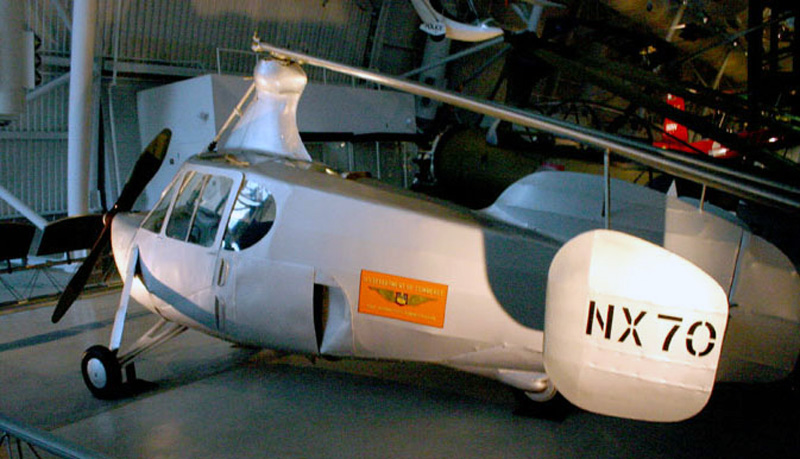| Pitcairn Autogiro |
|
AC-35 # |
 |
|
Photo: Robert Deering 10/23/2006 Smithsonian National Air and Space Museum Dulles International Airport (IAD) Chantilly, Virginia |
|
An aircraft in everyone’s garage—such was the aim of the
Autogiro Company of America’s
AC-35 roadable autogiro. Work began on this aircraft in 1935 when the Experimental Development Section of the Bureau of Air Commerce awarded a contract for the development of an advanced version of the PA-22, a small cabin autogiro built by the
Pitcairn Autogiro Company, of which the
Autogiro Company of America was a subsidiary. This new aircraft was one of six experimental aircraft manufactured for the bureau as part of its development program for private-owner aircraft types.
The AC-35 had many features designed to appeal to the public. The rotor blades could be folded back over the fuselage for ground travel and for storage in a 7 x 24-foot space, certainly small enough for the average-size garage. It could be flown by a licensed oilot who did not need rotary-wing-aircraft experience. On the road, the aircraft could reach a modest speed of 25 mph maximum. It seated two in a side-by-side arrangement and had hand baggage storage space behind the seats. The 90-hp Pobjoy ‘Cascade" engine was mounted behind the cabin. A shaft encased in a metal housing extended through the cabin between the two seats to the propeller installation. When the AC-35 made its first flight on March 26, 1936, it was equipped with two contrarotating propellers, but, because they produced excessive noise, they were replaced by a single propeller. The engine was also connected by a shaft to the tailwheel for use on the road. This wheel, on which the aircraft’s roadability depended, was the same size as the main wheels. For road use the rotor blades could be folded back over the fuselage, the propeller disengaged, and the tailwheel put in gear. The front wheels were used for steering. The fuselage was of welded steel tube construction with wooden fairing strips and metal and fabric covering; the tail section was entirely of wood with fabric covering. In addition to its use by the public as a pleasure craft, there were endless other possibilities for the AC-35—military and commercial transportation, aerial surveillance and photography, and police and forestry patrol, to mention only a few. On October 2, 1936, James G. Ray. vice president and chief pilot of the Autogiro Company of America, landed the AC-35 in a small downtown park in Washington. D.C., just north of the Department of Commerce building. There he converted the aircraft to its roadable configuration and drove it to the main entrance of the Commerce Building. It was accepted by John H. Geisse, chief of the Aeronautics Branch, and was taken to the department’s hangar at BoIling Field where further test flights were made. It was also demonstrated publicly at air shows and other gatherings during that year. In 1937 the Bureau of Air Commerce loaned the AC-35 back to the Autogiro Company of America for use in testing and perfecting a new design with which Pitcairn engineers were experimenting. It remained at Pitcairn Field until 1942 when it was returned to the Bureau of Air Commerce. In 1950 it was presented to the Smithsonian Institution for the National Aeronautical Collection. In 1961 Skyway Engineering Company. Inc.. of Carmel. Indiana. signed a contract with the Autogiro Company of America to obtain exclusive design rights, blueprints, test data and analyses. and patent rights in order to once again produce AC-35s. The company planned to replace the original Pobjoy engine with 135-hp Lycoming 0-290-D2Bs. raising the cruising speed from 75 to 120 mph and giving the aircraft a rate of climb of 700 feet per minute from a jump start. This later version was not roadable. however. Its range was 300—400 miles. and for extra convenience floats or skis could be added by the factory at special request. Skyway planned to sell the aircraft for $10,000 -- $15,000. One model was built and successfully test flown at Terry Field near Indianapolis in the mid-1960s. Shortly afterward. however, the company was dissolved because of internal problems. and no other AC-35s were built. SPECIFICATIONS: Source: Smithsonia National Air and Space Museum |
